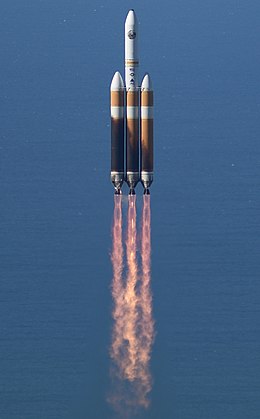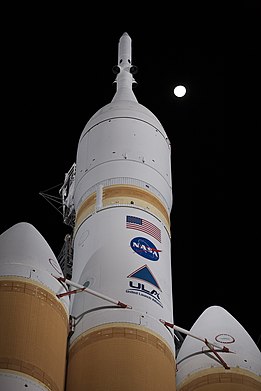Delta IV Heavy
 Delta IV Heavy launches from Vandenberg Space Force Base | |
| Function | Orbital heavy-lift launch vehicle |
|---|---|
| Manufacturer | United Launch Alliance |
| Country of origin | United States |
| Cost per launch | US$350 million [1] NRO: US$440 million |
| Size | |
| Height | 72 m (236 ft) |
| Diameter | 5 m (16 ft) |
| Width | 15 m (49 ft) |
| Mass | 733,000 kg (1,616,000 lb) |
| Stages | 2+ |
| Capacity | |
| Payload to LEO | |
| Mass | 28,790 kg (63,470 lb) |
| Payload to GTO | |
| Mass | 14,220 kg (31,350 lb) |
| Associated rockets | |
| Family | Delta |
| Comparable | |
| Launch history | |
| Status | Retired |
| Launch sites | |
| Total launches | 16 |
| Success(es) | 15 |
| Partial failure(s) | 1 |
| First flight | 21 December 2004 (USA-181) |
| Last flight | 9 April 2024 (NROL-70) |
| Type of passengers/cargo |
|
| Boosters ( LOX | |
The Delta IV Heavy (Delta 9250H) was an
The Delta IV Heavy first stage consisted of a central
The launch vehicle used three RS-68 engines, one in the central core and one in each booster.[10] On the last seconds of countdown, the liquid hydrogen fuel would flow through the engines and upwards along the booster body, and after the ignition that hydrogen inflamed, creating the characteristic fireball and charred look of the booster.[11]
History

The Delta IV line of rockets were developed by Boeing. The program was later transferred to United Launch Alliance. The Delta IV Heavy was the most powerful member of the line, which also includes the smaller Delta IV Medium.[12] The Delta IV Heavy can lift 28,370 kg (62,550 lb) to low Earth orbit and 13,810 kg (30,450 lb) to geostationary transfer orbit (GTO).[12] It was an all liquid-fueled launch vehicle, consisting of an upper stage, one main booster and two strap-on boosters.[12]
The first launch of the Delta IV Heavy on 21 December 2004 carried a boilerplate payload and was a partial failure. Cavitation in the liquid-oxygen propellant lines caused shutdown of both boosters eight seconds early, and the core engine nine seconds early; this resulted in a lower staging velocity for which the second stage was unable to compensate. The payload was left in a lower than intended orbit.[13]
Its first operational payload was the
On 12 August 2018, the Delta IV Heavy with an additional Star 48BV third stage was used to launch the Parker Solar Probe into an elliptical heliocentric orbit.[15] In May 2023, the final Delta IV Heavy core and boosters finished construction, officially ending Delta IV production and making way for the Vulcan launch vehicle.[16] The final Delta IV heavy would launch on April 9, 2024.[17]
Delta IV's final flight was initially scheduled for March 29, 2024 for the National Reconnaissance Office;[18][19] its actual launch date was April 9, 2024 after a postponement.[20][17][21]
Capabilities
Capacity of the Delta IV Heavy:
- Low Earth orbit (LEO), 200 km × 28.7°: 28,790 kg (63,470 lb) [22]
- Low Earth orbit (ISS), 407 km × 51.6°: 25,980 kg (57,280 lb) [23]
- Geosynchronous transfer orbit (GTO): 14,220 kg (31,350 lb) [22]
- Geosynchronous orbit (GEO): 6,750 kg (14,880 lb) [22]
- Lunar transfer orbit(LTO): 10,000 kg (22,000 lb)
- Mars transfer orbit: 8,000 kg (18,000 lb) [24]
The Delta IV Heavy's total mass at launch was approximately 733,000 kg (1,616,000 lb) and produce around 952,000 kg (2,099,000 lb) of thrust to power the rocket skyward at liftoff.[25]
Launch history
| Flight | Date | Payload [26] | Mass | Launch site | Outcome [26] |
|---|---|---|---|---|---|
| 1 | 21 December 2004 | DemoSat, Sparkie / 3CS-1 and Ralphie / 3CS-2 | ~13,228 pounds (6000 kilograms) | Cape Canaveral, SLC-37B | Partial failure[a] |
| 2 | 11 November 2007 | DSP-23 Defense Support Program |
11,574 pounds (5,250 kilograms) | Cape Canaveral, SLC-37B | Success |
| 3 | 18 January 2009 | Orion 6 / Mentor 4 (USA-202 / NROL-26) | Classified | Cape Canaveral, SLC-37B | Success |
| 4 | 21 November 2010 | Orion 7 / Mentor 5 (USA-223 / NROL-32) | Classified | Cape Canaveral, SLC-37B | Success |
| 5 | 20 January 2011 | ) | <37,479 pounds (17,000 kilograms) | Vandenberg, SLC-6 |
Success |
| 6 | 29 June 2012 | Orion 8 / Mentor 6 (USA-237 / NROL-15) | Classified | Cape Canaveral, SLC-37B | Success |
| 7 | 26 August 2013 | KH-11 Kennen 16 (USA-245 / NROL-65) | <37,479 pounds (17,000 kilograms) | Vandenberg, SLC-6 |
Success |
| 8 | 5 December 2014 | Orion Exploration Flight Test-1 (EFT-1) | 46,297 pounds (21,000 kilograms) [27][b] | Cape Canaveral, SLC-37B | Success |
| 9 | 11 June 2016 | Orion 9 / Mentor 7 (USA-268 / NROL-37) | Classified | Cape Canaveral, SLC-37B | Success |
| 10 | 12 August 2018 | Parker Solar Probe[c] | 1,510 pounds (685 kilograms) | Cape Canaveral, SLC-37B | Success |
| 11 | 19 January 2019 | NROL-71 | Classified | Vandenberg, SLC-6 |
Success |
| 12 | 11 December 2020 | Orion 10 / Mentor 8 (USA-268/ NROL-44)[28][29] | Classified | Cape Canaveral, SLC-37B | Success |
| 13 | 26 April 2021 | KH-11 Kennen 17 (NROL-82 )
|
Classified | Vandenberg, SLC-6
|
Success |
| 14 | 24 September 2022 | KH-11 Kennen 18 (NROL-91 )
|
Classified | Vandenberg, SLC-6 | Success |
| 15 | 22 June 2023 | Orion 11 / Mentor 9 (NROL-68)[30] | Classified | Cape Canaveral, SLC-37B | Success |
| 16 | 9 April 2024 | Orion 12 / Mentor 10 (NROL-70) | Classified | CCSFS, SLC-37B | Success |
Comparable vehicles
Current:
- Long March 5 (geostationary transfer orbit)
- Long March 5B(low Earth orbit)
- Long March 7A(geostationary transfer orbit)
- Falcon Heavy
- Proton-M
- Vulcan Centaur
- Angara A5
In development:
Retired or cancelled:
- Ariane 5 (retired)
- Atlas V Heavy (proposed, never developed)
- Saturn IB (retired)
- Titan III (retired)
- Titan IV (retired)
See also
- Comparison of orbital launch systems
- Comparison of orbital rocket engines
- National Launch System, (1991–1993) study
References
- ^ "ULA CEO Tory Bruno". twitter.com. Retrieved 12 February 2018.
Delta IV Heavy goes for about US$350M. That's current and future, after the retirement of both Delta IV Medium and Delta II.
- ^ "Delta IV Heavy". Spaceflight 101. Retrieved 26 July 2014.
- ^ a b "Delta IV Payload Planner's Guide, June 2013" (PDF). United Launch Alliance. Archived from the original (PDF) on 10 July 2014. Retrieved 26 July 2014.
- ^ "Delta IV Launch Services User's Guide" (PDF). United Launch Alliance. Retrieved 13 April 2024.
- ^ "Mission Status Center". Spaceflight Now. Retrieved 26 July 2014.
The ULA Delta 4-Heavy is currently the world's largest rocket, providing the nation with reliable, proven, heavy lift capability for our country's national security payloads from both the east and west coasts.
- ^ Chang, Kenneth (6 February 2018). "Falcon Heavy, SpaceX's Big New Rocket, Succeeds in Its First Test Launch". The New York Times. Retrieved 6 February 2018.
The Falcon Heavy is capable of lifting 140,000 pounds to low Earth orbit, more than any other rocket today.
- ^ "Boeing Delta IV Heavy Achieves Major Test Objectives in First Flight" (Press release). Boeing. 21 December 2004. Archived from the original on 19 April 2012. Retrieved 22 March 2012.
- ^ Erwin, Sandra (24 August 2020). "ULA to launch Delta 4 Heavy for its 12th mission, four more to go before rocket is retired". SpaceNews. Retrieved 29 August 2020.
- ^ "Delta IV Heavy - NROL-70". Next Spaceflight. 9 February 2024. Retrieved 10 February 2024.
- ^ "Delta 4-Heavy likely heading for geosynchronous orbit with top secret payload". Spaceflight Now. 26 August 2020. Retrieved 27 August 2020.
- ^ Berger, Eric (21 January 2019). "This massive rocket creates a fireball as it launches, and that's by design". Ars Technica. Retrieved 13 April 2023.
- ^ a b c Howell, Elizabeth (20 April 2018). "Delta IV Heavy: Powerful Launch Vehicle". Space.com. Retrieved 21 July 2018.
- ^ "Delta 4-Heavy investigation identifies rocket's problem". Spaceflight Now. 16 March 2005. Retrieved 26 July 2014.
- ^ "Second Stage Ignites as First Stage Falls Away". 5 December 2014.
 This article incorporates text from this source, which is in the public domain.
This article incorporates text from this source, which is in the public domain.
- ^ "Delta IV Parker Solar Probe". ulalaunch.com. Retrieved 11 December 2020.
- ^ "ULA's Delta rocket assembly line falls silent". Spaceflight Now.
- ^ a b "Delta IV Heavy NROL-70". www.ulalaunch.com. Retrieved 8 April 2024.
- ^ Chang, Kenneth (28 March 2024). "A Fiery Finale for a Rocket That Brings the Heat - The Delta IV Heavy, a rocket that briefly bursts into flame just before it lifts off, is set to launch for the last time soon". The New York Times. Archived from the original on 28 March 2024. Retrieved 29 March 2024.
- ^ Angle, Richard (15 March 2024). "United Launch Alliance's Delta IV Heavy readies for final flight". TESLARATI. Retrieved 21 March 2024.
- ^ Pare, Sascha (28 March 2024). "Secretive Delta IV Heavy rocket launch postponed indefinitely". livescience.com. Retrieved 30 March 2024.
- ^ published, Robert Z. Pearlman (9 April 2024). "'Heavy' history: ULA launches final Delta rocket after 64 years (video, photos)". Space.com. Retrieved 11 April 2024.
- ^ a b c "Delta IV Launch Services User's Guide – June 2013" (PDF). United Launch Alliance. 4 June 2013. pp. 2–10, 5–3. Archived from the original (PDF) on 14 October 2013. Retrieved 31 October 2020.
- ^ "Delta IV Data Sheet". Space Launch Report. Archived from the original on 6 December 2012. Retrieved 26 July 2014.
{{cite web}}: CS1 maint: unfit URL (link) - ^ Ray, Justin (7 December 2004). "The Heavy: Triple-sized Delta 4 rocket to debut". Spaceflight Now. Archived from the original on 11 December 2004. Retrieved 13 May 2014.
- ^ "Live coverage: Launch of Delta 4-Heavy rocket set for early Saturday". Spaceflight Now. 29 August 2020. Retrieved 29 August 2020.
- ^ a b Krebs, Gunter. "Delta-4". Gunter's Space Page. Retrieved 15 March 2018.
- ^ "NASA Orion Exploration Flight Test-1 PRESS KIT" (PDF). NASA. December 2014. p. 12.
 This article incorporates text from this source, which is in the public domain.
This article incorporates text from this source, which is in the public domain.
- ^ "Launch Schedule". Spaceflight Now. 27 October 2020. Retrieved 31 October 2020.
- ^ "Launch Mission Execution Forecast". 45th Weather Squadron - Patrick Air Force Base. 30 October 2020. Retrieved 31 October 2020.
 This article incorporates text from this source, which is in the public domain.
This article incorporates text from this source, which is in the public domain.
- ^ Clark, Stephen (22 June 2023). "Delta 4-Heavy rocket lifts off with NRO spy satellite". Spaceflight Now. Retrieved 27 June 2023.
